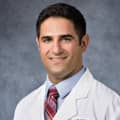Anterior cruciate ligament (ACL) knee injuries often happen suddenly and without warning. While any active adult can sustain an ACL injury, there are certain situations, activities, and risk factors that increase the likelihood of it occurring.
In This Article:
- Anterior Cruciate Ligament (ACL) Tears
- ACL Tear Symptoms
- ACL Tear: Causes and Risk Factors
- ACL Tear Diagnosis
- ACL Tear Treatment Options
- ACL Tear Surgical Repair
Causes of ACL Tears
An ACL tear is usually sudden and is regularly seen in both contact and non-contact sports. It often occurs:
- As a result of cutting or pivoting maneuvers, when an athlete plants a foot and suddenly shifts direction
- When a person lands on one leg, such as when jumping in volleyball or basketball
- When the knee is hit directly, especially when it is hyper-extended or bent slightly inward
- During a sudden slowing or stopping from running, which can cause the ligament to hyper-extend
- Through repeated stress to the knee, which can cause the ligament to lose elasticity (like a stretched out rubber band)
- When the knee is bent backward or twisted, which can occur during a fall or landing a jump awkwardly
See Understanding Knee Hyperextension
Sports injuries are the most common causes of ACL tears, however, the ACL can be injured during any trauma, such as during a car accident, falling off a ladder, or missing a step on a staircase.
Risk Factors: ACL Tears
While anyone can injure their ACL, certain factors can put an individual at higher risk:
- Female sex. The rate of ACL injuries is three times higher in female athletes than in males.1Sutton KM, Bullock JM. Anterior cruciate ligament rupture: differences between males and females. J Am Acad Orthop Surg. 2013 Jan;21(1):41-50. doi: 10.5435/JAAOS-21-01-41. Review. PubMed PMID: 23281470. While the exact reason is unknown, some reasons include differences in muscle conditioning, control, and strength.
- Participation in certain sports. ACL tears commonly occur in sports such as basketball, soccer, football, volleyball, downhill skiing, lacrosse, and tennis. These sports require frequent and sudden deceleration, such as cutting, pivoting, or landing on one leg.
- Previously torn ACL. The risk of re-tearing a previously repaired ACL is approximately 15% higher than the risk of tearing a normal ACL.2Wiggins AJ, Grandhi RK, Schneider DK, Stanfield D, Webster KE, Myer GD. Risk of Secondary Injury in Younger Athletes After Anterior Cruciate Ligament Reconstruction: A Systematic Review and Meta-analysis. Am J Sports Med. 2016;44(7):1861-76. One study notes that this risk is highest in the first year after the initial injury. The risk of an ACL tear in the opposite knee is also higher once the injury has occurred in the first.
- Age. ACL tears are most common between the ages of 15 and 45, mostly due to the more active lifestyle and higher participation in sports.
Having a risk factor does not mean a person will have an ACL injury in his or her lifetime.
Why Are Women at higher risk for ACL Injuries?
Women tend to injure their ACL more often than men because of differences in:
- Strength
- Anatomy
- Genetics
- Jumping and landing patterns
See Guide to Knee Joint Anatomy
Experts have recently gained a better understanding of women’s jumping and landing patterns and how they relate to ACL injuries. A particularly vulnerable and common landing position for ACL tears involves the knee and hip in an extended (straight) position when the athlete forcefully places an inward, or valgus, force on the knee.3Voskanian N. ACL Injury prevention in female athletes: review of the literature and practical considerations in implementing an ACL prevention program. Curr Rev Musculoskelet Med. 2013;6(2):158-63.
See Symptoms of Knee Hyperextension
ACL Tear Prevention
Hamstring stretches promote flexibility and reduce stress on the knee joint.
Recent attention has focused on prevention of ACL injuries, especially in young females who participate in high-risk sports.
- High-intensity jumping exercises
- Biomechanical analysis with direct feedback to the athlete to improve position and movement patterns, including cutting and landing techniques
- Strength training, especially of the hamstring and gluteus maximus muscles
- Proprioceptive training, such as use of a wobble-board, to improve muscle strength, balance, and reaction times
See Advanced Exercises to Restore Proprioception
Successful programs have been initiated at least 6 weeks prior to the sports season, followed by an in-season maintenance program that may replace the traditional warm-up.
In addition to changes in training, changes in footwear may decrease the chance of ACL injuries. Factors such as the length, shape, and number of cleats a shoe has may affect the risk of ACL injuries.4Silva DCF, Santos R, Vilas-Boas JP, Macedo R, Montes AM, Sousa ASP. Influence of Cleats-Surface Interaction on the Performance and Risk of Injury in Soccer: A Systematic Review. Appl Bionics Biomech. 2017;2017:1305479. doi:10.1155/2017/1305479 The type of surface a person plays on, such as turf or grass, may also affect the risk of an ACL tear. Speak with a health care provider for more information about playing conditions.
While some athletes wear knee braces to prevent ACL injuries, current clinical evidence does not support their use in ACL prevention.
- 1 Sutton KM, Bullock JM. Anterior cruciate ligament rupture: differences between males and females. J Am Acad Orthop Surg. 2013 Jan;21(1):41-50. doi: 10.5435/JAAOS-21-01-41. Review. PubMed PMID: 23281470.
- 2 Wiggins AJ, Grandhi RK, Schneider DK, Stanfield D, Webster KE, Myer GD. Risk of Secondary Injury in Younger Athletes After Anterior Cruciate Ligament Reconstruction: A Systematic Review and Meta-analysis. Am J Sports Med. 2016;44(7):1861-76.
- 3 Voskanian N. ACL Injury prevention in female athletes: review of the literature and practical considerations in implementing an ACL prevention program. Curr Rev Musculoskelet Med. 2013;6(2):158-63.
- 4 Silva DCF, Santos R, Vilas-Boas JP, Macedo R, Montes AM, Sousa ASP. Influence of Cleats-Surface Interaction on the Performance and Risk of Injury in Soccer: A Systematic Review. Appl Bionics Biomech. 2017;2017:1305479. doi:10.1155/2017/1305479






